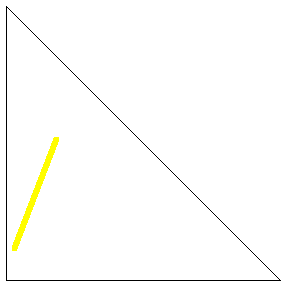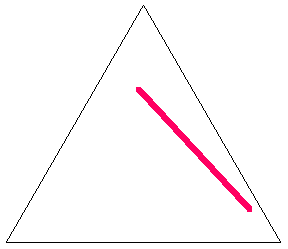
Consider the average length of a line segment determined by two points picked at random in the interior of an arbitrary triangle with side lengths
,
, and
. This problem is not affine, but
a simple formula in terms of the area or linear properties
of the original triangle can be found using Borel's overlap technique to collapse
the quadruple integral to a double integral and then convert to polar
coordinates, leading to the beautiful general formula
|
(1)
|
(A. G. Murray, pers. comm., Apr. 4, 2020), where is the semiperimeter
and
.
The formulas for odd moments have a similar form to that of the mean but with higher
powers of
,
,
,
and the triangle area
.
This formula immediately gives the special cases obtained below originally using brute-force computer algebra.

If the original triangle is chosen to be an equilateral triangle with unit side lengths, then the average length of a line with endpoints chosen at random inside it is given by
|
(2)
| |||
|
(3)
|
The integrand can be split up into the four pieces
|
(4)
| |||
|
(5)
| |||
|
(6)
| |||
|
(7)
|
As illustrated above, symmetry immediately gives and
, so
|
(8)
|
With some effort, the integrals and
can be done analytically to give the final beautiful result
|
(9)
| |||
|
(10)
|
(OEIS A093064; E. W. Weisstein, Mar. 16, 2004).
If the original triangle is chosen to be an isosceles right triangle with unit legs, then the average length of a line with endpoints chosen at random inside it is given by
|
(11)
| |||
|
(12)
| |||
|
(13)
| |||
|
(14)
|
(OEIS A093063; M. Trott, pers. comm., Mar. 10, 2004), which is numerically surprisingly close to .
The mean length of a line segment picked at random in a 3, 4, 5 triangle is given by
|
(15)
| |||
|
(16)
| |||
|
(17)
|
(E. W. Weisstein, Aug. 6-9, 2010; OEIS A180307).
The mean length of a line segment picked at random in a 30-60-90 triangle with unit hypotenuse was computed by E. W. Weisstein (Aug. 5, 2010) as a complicated analytic expression involving sums of logarithms. After simplification, the result can be written as
|
(18)
| |||
|
(19)
|
(E. Weisstein, M. Trott, A. Strzebonski, pers. comm., Aug. 25, 2010; OEIS A180308).
The expected distance from a random point in a general triangle to the vertex opposite the side of length
is
 |
(20)
|
(A. G. Murray, pers. comm., Apr. 4, 2020), with analogous expressions for
and
.
These give the beautiful identity
|
(21)
|
(A. G. Murray, pers. comm., Apr. 4, 2020).